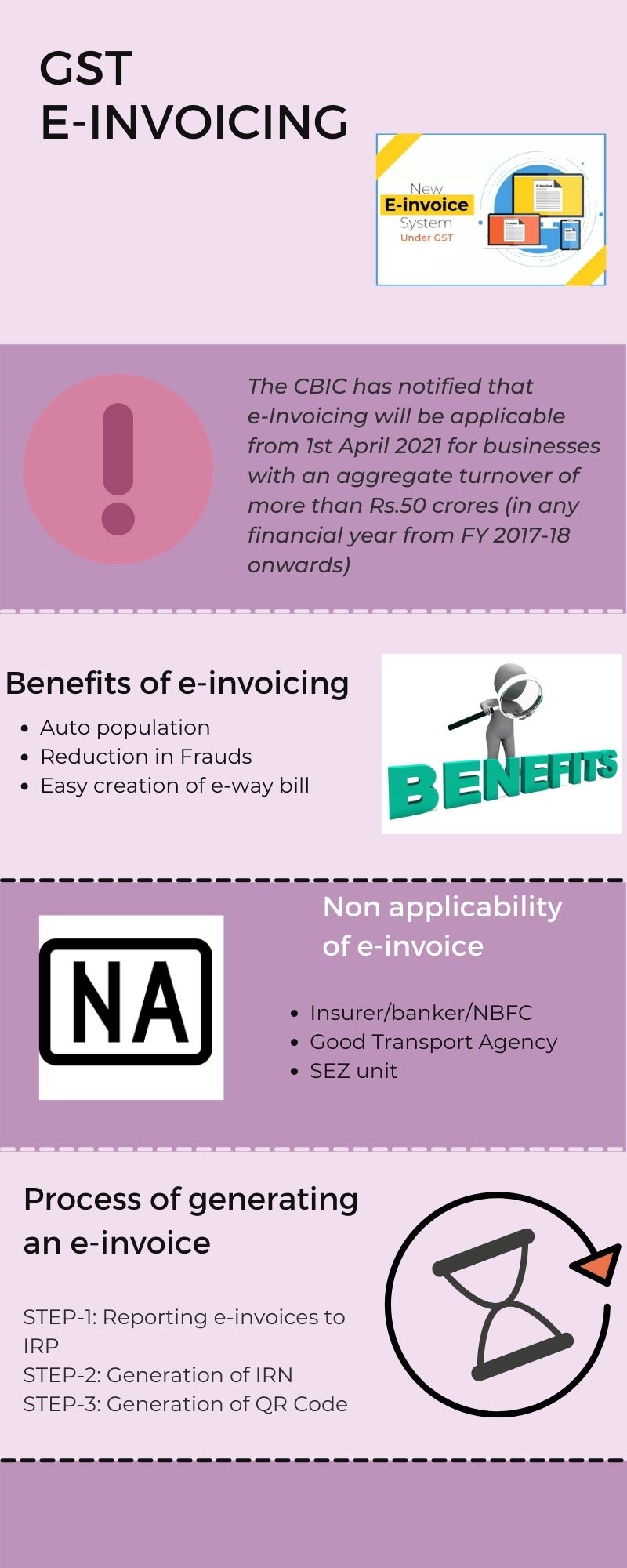TURNOVER LIMIT TO COMPLY WITH E-INVOICING

What is E-invoice?
E-Invoicing involves the submission of an already generated standard invoice on a common e-invoice portal. It facilitates exchange of invoice document between a supplier and buyer in an integrated electronic format by way of standard e-invoice schema through looping the invoicing portal to keep a check on suspicious taxpayers.
Non-Applicability of e-invoice generation: -
E-Invoice Generation shall not be applicable in the following cases: -
• Registered Individuals/businesses whose turnover is not exceeding the prescribed limit (currently 50 crores)
• An Insurer or a Banking company or a financial institution, including NBFC
• A Good Transport Agency
• A registered Person supplying Passenger Transportation services
• A registered person supplying services by way of admission to the exhibition of cinematographic films in multiplex services
• An SEZ unit (excluded via CBIC Notification No. 61/2020 – Central Tax)
How to generate an e-invoice?
E-Invoicing involves the submission of an already generated standard invoice on a common e-invoice portal. It facilitates exchange of invoice document between a supplier and buyer in an integrated electronic format by way of standard e-invoice schema through looping the invoicing portal to keep a check on suspicious taxpayers.
Step1:- Creation of the invoice on the taxpayer’s ERP:
The taxpayer will continue to generate invoices in the normal course of business. However, the reporting of these invoices electronically has criteria. It needs to be done as per the e-invoice schema along with mandatory parameters.
Step 2 – Generation of the unique IRN:
The IRN (also known as hash) is a unique number which is generated by the e-invoice system using a hash generation algorithm. For every document submitted, a unique 64-character IRN will be generated. At present, the e-invoice system provides the two modes to generate the IRN (Invoice Reference Number), i.e offline and API (Application Programming Interface). Notified taxpayers who need to generate e-invoices, can generate them using these options:1. Using the offline tool
2. Using API (Through GSPs integration)
3. Using API (Through direct integration)
4. Using API (Through an enabled sister concern’s GSTIN)
5. E-way Bill API-enabled Taxpayers
Step 3 – Generation of the QR Code:
The e-invoice system will generate the IRN, and then digitally sign the e-invoice and the QR code (quick response code). The QR code will enable a quick view, and validation and access of the invoices from handheld devices. The QR code will consist of the following parameters:
1. The GSTIN of supplier
2. The GSTIN of recipient
3. The invoice number as given by supplier
4. The date of generation of the invoice
5. The invoice value (taxable value and gross tax amount)
6. The number of line items
7. The HSN code of the main items (the line item having the highest taxable values)
8. The unique IRN (hash)
The digitally signed QR code will have the unique IRN (hash) which can be verified on the central portal, as well as by offline apps. This will be helpful for tax officers who need to check invoices in places where internet connection may not be available, such as on highways.
Major Challenges of E-invoicing Under GST:-
• If the invoice is found not registered on the IRP, such invoice will not be considered as a valid tax invoice for all GST related matters and hence a penalty of ₹ 10,000 will be incurred for each instance of non-compliance
• Transportation of goods without a valid tax invoice can be a reason for the detention of goods and vehicles and fines will be also imposed
• Customers may deny accepting and/or pay goods if a valid tax invoice is not available as this would affect the receiver’s eligibility to receive ITC benefits
• In addition, the government plans to implant a check that will prohibit the generation of an e-way bill if the IRN is absent
CONCLUSION
The Government claims that huge advancements in technology, increased penetration of the Internet, along with availability of computer systems at reasonable cost has made ‘e-invoice’, a popular choice worldwide. It hopes that this system will help in enhancing ease of doing business. So far, e-invoicing has seen a smooth implementation without any critical failure in the GST portal.
Disclaimer:“Information contained herein is for informational purposes only and should not be used in deciding any particular case. The entire contents of this document have been prepared on the basis of relevant provisions and as per the information existing at the time of the preparation. Though utmost efforts have been made to provide authentic information, it is suggested that to have better understanding and obtaining professional advice after thorough examination of particular situation.”
Please share:
Prepared By

Palaniappan.S
Articled assistant
Date: 15-05-2021